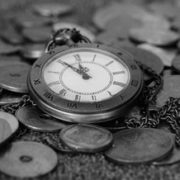8 Ways to Get Financially Fit in Your 40’s (Part 1)
Many people consider the prospect of turning 40 as a negative. We’re getting older and our bodies are starting to show their signs of wear and tear. Life as we knew it no longer exists; it’s time to buckle down and really start being an adult. Well, part of this is true. Turning 40 means we’ve officially hit the “middle age” mark. It’s time to start considering our future as much as the present.
For me, the old saying “Life begins at 40” couldn’t be more true. It’s a time to reflect on lessons learned. A time to use the past to help write our future. To quote one of America’s greats, Benjamin Franklin, “at 20 years of age the will reigns; at 30 the wit; at 40 the judgment.” The wisdom we gain in the first half of our lives is instrumental in shaping the second half.
No matter what life changes you’ll experience over the next decade, many of us view our 40’s as a time to get serious about financial planning. It’s our first true glimpse at mortality and it awakens us to the truth – we still have 20-30 years to save and invest for our retirement years. And, if done correctly, we can release the shackles our past financial decisions have placed on us and take back our financial freedom.
Let’s check out some expert advice that everyone in their 40’s (or even 30’s) should seriously consider enacting in order to lay the groundwork now for financial security in the future.
1) Start an Emergency Fund
Have you ever been blindsided by life? Imagine car trouble and a medical emergency, all within a few days or weeks of each other. The financial and emotional stress can send you into a tailspin, leaving you scrambling to make it all work.
Most people in this situation have to borrow money or charge these unexpected events to a credit card, leading to a cycle of debt and financial insecurity. In fact, according to a recent NeighborWorks America survey, 34% of Americans have no rainy day savings to fund these unexpected emergencies.
So, how can you prepare for a rainy day? Well, that depends upon your unique situation. Experts suggest having a minimum of one month’s worth of take-home pay set aside. Ideally, three months salary should be your target number. For those who are self-employed or have a more inconsistent income, you should plan for up to 9 months in savings.
2) Manage Your Debt-to-Income Ratio
Your debt-to-income ratio (DTI) is the figure lenders use to gauge how well you manage your debt. To ascertain your DTI, add up all of your minimum monthly loan/debt payments and divide the sum by your gross monthly income.
For example, if your home mortgage is $1,200/month, $400 for your vehicle, and you owe $300 monthly for minimum credit card payments, your monthly debt total is $1,900. With a gross monthly income of $3,900, your DTI would be approximately 49%.
DTI is one of the most critical components lenders look at when considering approving a loan. The lower the number, the less of risk you’re considered. While there’s no set rule regarding the numbers, experts recommend maintaining a DTI of 25% or less.
3) Get Serious About Unsecured Debt
Unsecured debt is one of the biggest financial burdens young adults take on. They carry the highest interest rate and you have nothing to show for it in the end except snowballing debt.
To determine if you’ve taken on too much unsecured debt, do an analysis. Itemize your debt by interest rate, so you have a clear picture of what you’re up against. Then, devise a plan to pay it off, ideally in the next five years. Consider tackling the credit card with the highest interest rate first. Pay the minimums on all other cards, putting all extra monies towards the high-interest card until it’s paid off. You’ll be reducing your debt-to-income ratio, improving your credit score, and putting yourself in a better situation financially.
Whether you have a significant amount of unsecured debt, or have kept it in check, it’s best to pay cash for as much as possible. This ensures you only purchase what you can afford.
4) Manage Your Credit Score
Another tool lenders use during the loan qualification/underwriting process is your credit score. Your FICO score can range anywhere from 300 to 850, with 850 being the best. While standards regarding what constitutes a good or bad score vary from lender to lender, the below is a good reference when determining your credit health. And the lower the score, the higher your interest rates (assuming you qualify) on everything from your home loan, to auto loans and credit cards.
Excellent Credit: 750+
Good Credit: 700-749
Fair Credit: 650-699
Poor Credit: 600-649
Bad Credit: below 600
To determine your credit score, we recommend checking with all three credit bureaus – Equifax, Experian and TransUnion. Everyone is entitled to one free credit report, per credit bureau, annually.
Stay tuned for Part 2, where we explore additional strategies for achieving financial freedom in your 40’s. Remember, it’s never too late!



Leave a Reply
Want to join the discussion?Feel free to contribute!